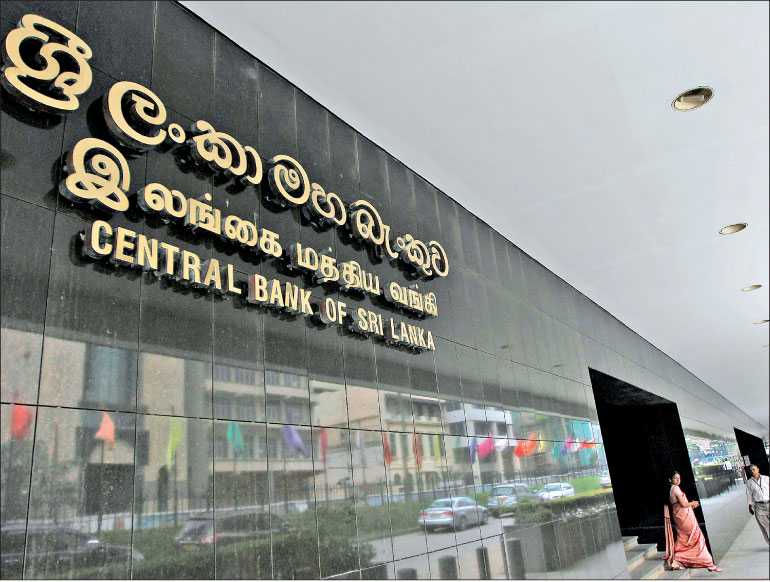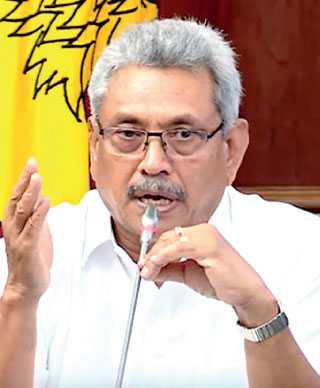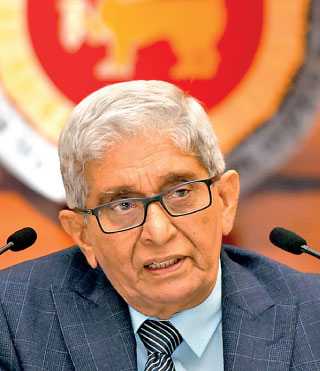Saturday Apr 20, 2024
Saturday Apr 20, 2024
Monday, 22 June 2020 00:30 - - {{hitsCtrl.values.hits}}

It is of importance that the Central Bank should issue guidelines to banks as to how they should rate those whose names are there in the CRIB register and assess the risk involved in accommodating such borrowers
A Presidential outburst
Last week, the media were abuzz with a video showing an angry President Gotabaya Rajapaksa reprimanding the senior officials of the Central Bank for the lacklustre growth in credit flows in the country. It is not clear whether the Monetary Board – the legal body responsible for this alleged lapse – was present at this meeting officially. Only two members out of the present three, Governor of the Central Bank and the Secretary to the Ministry of Finance, had been there in their respective official capacities. Hence, it was an outburst directed against the Central Bank officers sans the Monetary Board.
Fire-hose policies adopted under duress do not work
However, after this unexpected onslaught, the Board had done what it should not have done as a professional policy making body. It has made a series of decisions under duress, driven by panic and as outside analysts have branded, out of fear. Such hasty actions do not allow the policy makers to consider all the consequences of the policies they make. As the 19th century French economist Frédéric Bastiat called it, any policy that takes into account only what is seen and not what is to be foreseen is a bad economic policy. Branding the panic driven policies being adopted worldwide to overcome the bad economic fallout of COVID-19 pandemic as ‘fire-hose’ policies, Nobel Laureate Joseph Stiglitz, supported by Hamid Rashid, has warned that the moneys released as a solution to the liquidity crunch in the pandemic would just sit idle in bank accounts waiting for better economic opportunities in the future, thus frustrating the objectives of the policy makers (available at: https://www.project-syndicate.org/commentary/stimulus-policies-must-benefit-real-economy-not-financial-speculation-by-joseph-e-stiglitz-and-hamid-rashid-2020-06). Stiglitz and Rashid: Money released under duress will remain idle in bank accounts Say the duo: “Much of the money that households and businesses receive in the form of stimulus checks will probably sit idle in their bank accounts, owing to anxieties about the future and a broader reduction in spending opportunities. At the same time, banks will likely have to sit on the excess liquidity, for lack of credit-worthy borrowers willing to take out fresh loans.” Knowingly or unknowingly, the Monetary Board appears to have fallen into this trap.
 |
| President Gotabaya Rajapaksa |
 |
| Prime Minister Mahinda Rajapaksa |
 |
| Central Bank Governor Prof. W. D. Lakshman
|
Cutting SRR and flooding the banking sector
One of the decisions made by the Monetary Board in haste was to inject additional liquidity to banks amounting to about Rs. 115 billion by cutting the Statutory Reserve Ratio or SRR from 4% to 2%. SRR is a legal requirement under which all commercial banks have to make a special deposit with the Central Bank based on the deposits they have accepted from their customers. Under the previous requirement, if a bank had accepted a deposit of Rs. 100, Rs. 4 had to be kept as a reserve with the Central Bank and that money was not available to the bank for lending. Under the revised ratio, only Rs. 2 has to be kept with the Central Bank and the additional Rs. 2 is now available for the bank to lend to its customers.
Creation of a refinance fund without supporting reserves
The other policy measure was to top up the special refinance fund of Rs. 50 billion already set up in the Central Bank to provide relief to businesses affected by COVID-19 pandemic with an additional sum of Rs. 100 billion. This Rs. 100 billion was a sum approved by the Cabinet earlier and now the Monetary Board has given effect to that decision by using its ability to print money.
The Board has to print money for this purpose because the Central Bank’s free reserves that are available for this purpose is just Rs. 41 billion, much less than the Board’s total commitments. Hence, the Board’s decision to build a refinance fund of Rs. 150 billion on the request of the government is just like an unborn baby hanging outside the body of a pregnant woman. In my view, it is a gamble which the Board should not have taken.
It’s the government which would have funded the refinance fund
In the circumstances, such refinance facilities should have been funded out of taxpayers’ money but given the fragile condition of the government budget, there is no space available for the government to offer it. Under the proposed refinance scheme, commercial banks can meet the demand for loans by affected customers by borrowing funds at 1% from the Central Bank and on-lending the same at 4% thereby keeping a margin of 3% to cover administration costs and other expenses. As such, banks are not supposed to make profits out of these transactions. These two measures have received the nod of the President subsequently.
Increasing cash when banks have enough unused cash balances
Both measures will increase the cash availability to commercial banks for lending – known as liquid funds. Hence, in the opinion of the Monetary Board, pumping liquidity to the banking system amounts to removing the most pressing stumbling block that has constrained credit flows. But this diagnosis of the Board appears to be ill-conceived.
Parking excess cash with the Central Bank
Sri Lanka’s commercial banks are at present in a state of a massive excess liquidity. They are sitting on a huge amount of cash but there are no matching loan applications to dispense it. Hence, on a day to day basis, they have been parking their excess cash in an interest earning deposit with the Central Bank under its Standing Deposit Facility or SDF at 5.5%. At the time the Board decided to cut SRR by 2%, the banking sector was with an excess liquidity of about Rs. 100 billion which they had deposited with the Central Bank under SDF. Hence, as expected, when another Rs. 115 billion was released to banks through this cut in SRR, the excess liquidity immediately shot up to Rs. 223 billion. Banks have deposited this excess cash with the Central Bank earning 5.5% as interest per annum. Of course, this will be reduced gradually when banks begin to entertain more and more loan applications but it would take time.
The immediate result has been the shrinkage of the daily volume in the interbank call money market from Rs. 12 billion to Rs. 100 million and a reduction in the rates from 6.78% to 6.65%.
Hence, in the interim period, this has become a lucrative business for commercial banks to earn a risk-free income of about Rs. 12.26 billion per annum or Rs. 33 million a day. As such, the longer they keep this money with the Central Bank without lending, the higher the addition to their profits by way of a windfall gain. Any smart banker would follow this strategy as long as it is possible to do so. It proves Stiglitz and Rashid, but it would frustrate the objective of the Central Bank and the government.
‘Open Mouth Operations’ by central bankers
The Central Bank cannot correct this anomaly by resorting to what is humorously known as OMO or Open Mouth Operation. In this type of redefined OMO, the Governor will open his mouth in a threatening manner and command banks to increase their lending. In this respect, the past experience had been that banks, out of respect for the Governor, may choose to keep their heads down but would do the minimum to translate Governor’s OMO commands into practical action in the field. There are two reasons for this. One is that banks’ prime responsibility is not to the Governor but to their depositors.
They make a solemn promise each time they accept a deposit that those moneys would be used by them prudently earning an income and sharing that income with depositors by way of paying interest to them. This prudence does not allow them to waste the depositors’ money by lending to unworthy customers.
The other reason is that if borrowers are not of good quality, banks would not put their money at risk by lending to them. Hence, whether the credit flows would increase or not would depend on how many of the borrowers knocking at the door of the banks are worthy customers. If they are scanty, however much the Governor would open his mouth, credit will not move at the rate expected by the Monetary Board or the government. When there is a lucrative business without risk is available under Central Bank’s monetary policy windows, nothing can prevent banks from using it. Another unintended consequence is that banks, filled to the brim with excess cash, would refrain from canvassing for deposits at least in the immediate period.
CB will have to cut its policy rates to dissuade banks from parking excess cash with the bank
To dissuade banks from keeping excess money with the Central Bank without lending, the Central Bank has to cut its policy rates drastically once again. This applies to both the Standing Deposit Facility Rate or SDFR and the Standing Lending Facility Rate or SLFR. SDFR, as explained above, is the rate at which commercial banks can keep their excess cash temporarily with the Central Bank.
In the opposite, SLFR is the rate at which commercial banks can borrow money from the Central Bank to meet their urgent cash requirements. SDFR at present is 5.5%, while SLFR is 6.5%. Since banks can earn a minimum of 4% under Central Bank’s special refinance facility, SDFR should be brought below that rate. A possible SDFR is 3% and SLFR, 4%. But this would cause the entire interest rate structure in the country to move downward producing gainers as well as losers.
The biggest losers are the depositors who have kept their savings in bank deposits to earn a comfortable income for their living. When the actual income they get declines due to the interest rate cuts, they will experience a deterioration in their living standards. This is particularly applicable to senior citizens and those who depend on interest incomes. This will certainly be the cause of social chaos. The gainers are the borrowers, the government and those in the private sector. Both parties will find a fall in interest payment commitments leaving a sizable cash savings which they can use for other purposes. A likely unintended consequence is the development of an informal financial services market that would lure depositors of banks on the promise of higher interest rates. These are not the developments which the Monetary Board may have anticipated.
Address the structural issues
Thus, the blockage of credit flows is not a liquidity problem but a structural problem. Banks in the exercise of their prime responsibility to the depositors may not want to put the depositors’ money at risk. Presently, the risk mitigation involves getting suitable collateral for loans, limiting loans to a single customer to a maximum, adopting a multi-tier loan approval process within banks and building capital within banks to provide a minimum protection to depositors. In an emergency in which both the government and the Monetary Board want to promote credit flows, these structural problems certainly stand in their way.
Sri Lanka’s bankers are not yet ready to assess the viability of a project and accommodate its credit requirements. Hence, it will take time to move from the present collateral based lending to project-viability based lending. Hence, to take the fear of lending out of the mindset of bankers, it is necessary to provide a comprehensive credit guarantee scheme to bankers. That could be funded out of a seed capital to be given by the government initially and out of subscriptions of the banks that would get the benefits from the scheme. An automatic subscription flow can be generated by charging a premium of 1% annually from the loans granted out of the refinance funds of the Central Bank.
CRIB reports are just indicators and not eliminators
The other structural problem is the overreliance on the reports from the Credit Information Bureau, known in its acronym as CRIB, when sanctioning loans. As the founding General Manager of CRIB, I could say that the objective of these credit reports was not to eliminate borrowers. They were simply an indicator of the likelihood of habitual loan default by prospective customers which the sanctioning bank could take into account when assessing the credit risk involved. Then, like good bankers, they could take measures to mitigate the risk through additional collateral or charging a higher interest rate. Instead of assessing loans appropriately, the bankers are in the habit of rejecting those whose names are in the CRIB register. There are small as well as large borrowers in this category. Some have got their names into CRIB register simply because they have failed to pay credit card instalments or they have guaranteed a loan which has been defaulted by the original borrowers. There are also non-executive company directors whose names have been reported to CRIB because the company concerned has defaulted payments.
It is of importance that the Central Bank should issue guidelines to banks as to how they should rate those whose names are there in the CRIB register and assess the risk involved in accommodating such borrowers.
A cure worse than the disease
Therefore, simply increasing the liquidity in the system will not improve credit flows unless these structural issues are addressed. The excess liquidity created by the Monetary Board will remain within the system as a virus for which there is no effective vaccine.
The interest payments which the Board has to make to absorb that excess liquidity will be extremely costly for the Bank. To soften it, the Board can reduce SDFR and SLFR. But that cure will be worse than the ailment since the across the board decline in the whole interest rate structure will create many long-term macroeconomic issues.
Some undesirable outcomes would be the dwindling of the savings flows, rising savings-investment gaps, need for borrowing abroad to fill the gap, trapping the country in an external debt trap and above all, pressure for the rupee to depreciate in the market. These costs would have been avoided by the Board if it had gone for a credit guarantee scheme and streamlined CRIB reports when assessing loan applications.
(The writer, a former Deputy Governor of the Central Bank of Sri Lanka, can be reached at [email protected].)